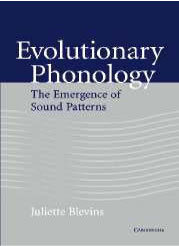Project Members
- Juliette Blevins
- Sven Grawunder
- Dave Kamholz (University of California at Berkeley)
- Andrew Wedel (University of Arizona)
Advances in Evolutionary Phonology

Evolutionary Phonology seeks to explain why certain sound patterns have the typological distributions they do. Why are certain sound patterns extremely common, while others are rare? What factors play a role in determining similar sound patterns across languages? And what is the ultimate explanation for the striking identity between recurrent context-dependent instances of sound change and recurrent alternation types across the world's languages?
Within Evolutionary Phonology, the attempt to explain recurrent sound patterns gives equal consideration to all potential sources of similarity. As with similar biological characteristics, two languages may have similar sound patterns due to: (i) inheritance from a mother tongue; (ii) parallel evolution in the form of parallel phonetically motivated sound change; (iii) physical constraints on form & function, including innate aspects of speech perception & production, potential phonological universals, and general cognitive mechanisms; (iv) 'non-natural' or external factors (e.g. language contact, prescriptive norms, literacy, second-language learning); (v) or mere chance. This general approach to explanation in Evolutionary Phonology is rooted in the view of language as a complex adaptive system whose evolution can be usefully compared to the evolution of biological organisms.
Present research explored the form and distribution of recurrent sound patterns, and the multiple ways sound patterns can be modeled as emergent probabilistic properties, resulting from the repeated interaction of innate perceptual and articulatory biases, self- organizing properties of sound systems, and aspects of language use within a population. While new discoveries continue, the successful application of the evolutionary approach required a comprehensive summation of qualitative and quantitative aspects of sound change.
To provide a sound empirical basis for the study of sound change, a Sound Change Database was compiled. Its purpose was to provide a searchable database for phonologists, historical linguists, and phoneticians, as well as for general linguists interested in the nature and origins of sound patterns. In this database, regular sound changes established by experts in the historical phonology of relevant languages and language families were compiled, and organized by phonetic origin, genealogical affiliation, general type, and other more specific attributes. For each regular sound change, there was a summary of relevant phonetic work, as well as a summary of parallel synchronic sound patterns in the world's languages. Printed indices as well as search functions in the electronic database allow researchers to investigate a sound change or sound pattern by general type, phonetic basis, target segment or structure, output segment or structure, as well as by language or language family. As a compendium of regular sound changes, related sound patterns, and phonetic explanations for sound patterns, the database is valuable to those working in the traditional fields of historical linguistics, phonology, and phonetics. At the same time, the database was meant to provide an empirical basis for innovative research in phonology. Phonologists can more easily deconstruct synchronic sound patterns into natural and unnatural components, once a compendium of natural patterns exists.
Publications
Some publications:
Blevins, J. 2007. Endangered sound patterns: Three perspectives on theory and description. Language Documentation and Conservation 1: 1-16.
Blevins, J. 2006. A theoretical synopsis of Evolutionary Phonology (target article). Theoretical Linguistics 32:117-65.
Blevins, J. 2006. New perspectives on English sound patterns: 'Natural' and 'Unnatural' in Evolutionary Phonology. Journal of English Linguistics 34:6-25.